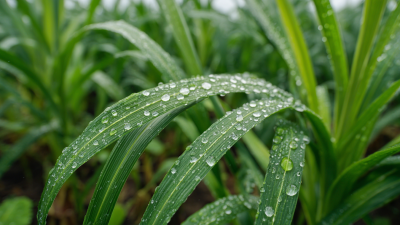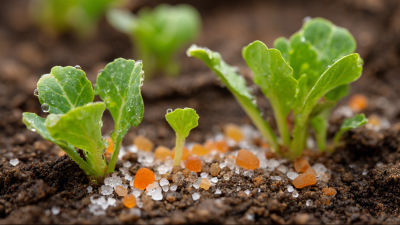
The integration of Water Soluble Phosphatic Fertilizers into farming practices not only promotes healthier plant growth but also supports sustainable approaches to soil management. With the ability to dissolve and be absorbed more efficiently, these fertilizers reduce the risk of nutrient runoff, contributing to cleaner water sources and healthier ecosystems. As farmers look for solutions that align with eco-friendly practices, Water Soluble Phosphatic Fertilizers represent a step towards more responsible nutrient management.
In this exploration, we will unlock the myriad benefits of Water Soluble Phosphatic Fertilizers, highlighting their role in promoting sustainable agriculture through improved nutrient delivery systems. By examining practical applications and real-world outcomes, we can better understand how these innovative fertilizers are shaping the future of farming in a more sustainable and productive direction.
Water soluble phosphatic fertilizers (WSPF) are becoming increasingly vital in sustainable agriculture due to their ability to deliver essential nutrients efficiently. These fertilizers dissolve quickly in water, allowing for immediate uptake by plants and minimizing nutrient runoff. According to the Food and Agriculture Organization (FAO), the adoption of WSPF can lead to a 15-30% increase in crop yield compared to traditional fertilizers. This enhanced nutrient availability not only optimizes plant growth but also promotes healthier soil ecosystems.
In understanding the science behind WSPF, it's essential to note that they typically contain monoammonium phosphate (MAP) or diammonium phosphate (DAP). These compounds provide not just phosphorus, but also nitrogen, aiding in the balanced fertilization crucial for plant development. The nutrient release pattern of WSPF allows for targeted applications, accommodating varying crop needs throughout different growth stages. As per a report from the International Fertilizer Association, precise nutrition management using WSPF can lead to significant reductions in environmental impacts.
**Tips:**
1. Use WSPF during critical growth phases of crops to maximize nutrient uptake and crop performance.
2. Consider soil testing prior to applying fertilizers to better understand nutrient requirements tailored to specific crops.
3. Implement fertigation (fertilizer application through irrigation) with WSPF to enhance nutrient absorption and minimize waste.
This bar chart illustrates the key benefits of water soluble phosphatic fertilizers in sustainable agriculture, highlighting aspects such as solubility in water, nutrient uptake efficiency, environmental impact, and crop yield improvement.
Water soluble phosphatic fertilizers are gaining traction in sustainable agriculture due to their numerous advantages in crop production. One of the primary benefits is their enhanced nutrient availability. Unlike traditional fertilizers that may be limited in solubility, water soluble phosphatic fertilizers dissolve easily in water, facilitating immediate uptake by plants. This characteristic ensures that crops receive essential phosphorous, leading to better root development and increased overall plant vigor.
Additionally, the use of water soluble phosphatic fertilizers promotes efficient nutrient management. Farmers can tailor application rates based on soil tests and crop requirements, minimizing waste and reducing the environmental impact associated with excess fertilizer use. This precision contributes to sustainable agriculture practices by improving crop yields while conserving resources. Furthermore, these fertilizers can be applied through various irrigation systems, enhancing their usability in diverse agricultural settings. Overall, the integration of water soluble phosphatic fertilizers into farming strategies not only optimizes crop production rates but also aligns with sustainability goals.
| Benefit | Description | Impact on Crop Production | Recommended Crops |
|---|---|---|---|
| Enhanced Nutrient Uptake | Water soluble phosphatic fertilizers improve the availability of phosphorus to plants. | Increased crop yield and better quality produce. | Vegetables, Fruits, and Grains |
| Quick Nutrient Release | These fertilizers dissolve in water, providing nutrients quickly to crops. | Faster growth rates during critical growing phases. | Leafy Greens and Fast-Maturing Crops |
| Soil Health Improvement | Helps in promoting beneficial microbial activity in the soil. | Long-term fertility and sustainability of the soil. | Perennials and Cover Crops |
| Reduced Risk of Over-Fertilization | Controlled application and precise dosing can minimize wastage. | Lowered environmental impact and enhanced nutrient-use efficiency. | All Crops |
| Compatibility with Other Inputs | Water soluble formulas can be mixed with other fertilizers for comprehensive nutrition. | Enhanced synergistic effects and optimized crop nutrition. | Field Crops and Horticultural Plants |
 Water soluble phosphatic fertilizers are essential for enhancing crop productivity, particularly in sustainable agricultural practices. The application of these fertilizers must be done with precision to maximize their benefits. First and foremost, it is important to conduct soil tests to determine existing nutrient levels. This helps in tailoring the fertilizer application to the specific needs of the crops and avoiding over-fertilization.
Water soluble phosphatic fertilizers are essential for enhancing crop productivity, particularly in sustainable agricultural practices. The application of these fertilizers must be done with precision to maximize their benefits. First and foremost, it is important to conduct soil tests to determine existing nutrient levels. This helps in tailoring the fertilizer application to the specific needs of the crops and avoiding over-fertilization.
When applying water soluble phosphatic fertilizers, the timing and method of application play critical roles. For instance, applying these fertilizers during the early stages of plant growth can significantly boost root development and overall vigor. Fertigation, which involves applying the fertilizer through irrigation systems, is considered one of the most effective methods, ensuring uniform distribution and rapid uptake by plants. Additionally, it’s advisable to consider environmental factors such as temperature and humidity, which can affect nutrient absorption and effectiveness.
By adhering to these best practices, farmers can optimize the use of water soluble phosphatic fertilizers, promoting sustainable agricultural systems while enhancing crop yields.
The comparison between water-soluble phosphatic fertilizers and traditional phosphatic fertilizers highlights significant differences in their effectiveness and environmental impact. Water-soluble fertilizers dissolve easily in water, making nutrients readily available for plant uptake. This quick absorption leads to improved nutrient efficiency, allowing farmers to achieve higher yields without the risk of nutrient runoff or soil degradation commonly associated with conventional fertilizers. The immediate availability of nutrients encourages healthier plant growth and enhances crop productivity, especially in nutrient-deficient soils.
In contrast, traditional phosphatic fertilizers often require microbial action in the soil to break down, which can lead to delayed nutrient availability. This slow release can hinder optimal plant growth during critical stages, ultimately lowering crop performance. Additionally, traditional fertilizers can contribute to soil acidification and long-term nutrient imbalances, which may compromise sustainable farming practices. By leveraging the advantages of water-soluble phosphatic fertilizers, farmers can foster a more sustainable agricultural system that prioritizes efficient resource use and environmental stewardship.
Integrating water soluble phosphatic fertilizers into sustainable farming systems has gained significant attention in recent years, fueled by the growing need for efficient resource use in agriculture. The North American water soluble fertilizers market alone was valued at approximately USD 504.24 million in 2024 and is projected to reach USD 522.14 million in 2025. This growth reflects a broader trend towards sustainable farming practices that prioritize not only crop yield but also environmental health.
The global market for water soluble fertilizers is anticipated to see a staggering increase, projected to reach around USD 28.2 billion by 2035. This surge is largely driven by advancements in sustainable and precision farming technologies that enhance agricultural productivity while minimizing negative environmental impacts. In fact, innovations such as smart hydrogels are emerging to address challenges such as water scarcity and the need for efficient nutrient delivery systems, further supporting the adoption of water soluble phosphatic fertilizers.






